

Gaze-activated dresses with eye-tracking technology by Ying Gao. Fashion X Technology: Ying Gao. Smart Bionic Limbs are Reengineering the Human. The second arm funded by the Revolutionizing Prosthetics program, the Modular Prosthetic Limb (MPL), developed at Johns Hopkins University, may lead to what many believe is the endgame for bionics: direct neural control.
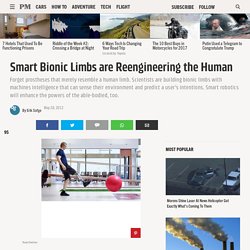
By embedding electrodes into a subject's existing nerves, or going through the skull and implanting them directly onto his or her cortex, researchers have been able to turn thoughts into action. These high-tech ballet shoes visualize a dancer's movements as works of art. (Photo : Lesia Trubat) Technology and ballet is a strange combination, but when they meet, the results can be beautiful.
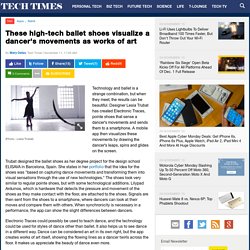
Designer Lesia Trubat has created Electronic Traces, pointe shoes that sense a dancer's movements and sends them to a smartphone. A mobile app then visualizes these movements by drawing the dancer's leaps, spins and glides on the screen. Trubat designed the ballet shoes as her degree project for the design school ELISAVA in Barcelona, Spain. New Artificial Skin Is Sensitive to Touch and Feels Changes in Pressure. It's thin, flexible, made of organic material, and understands a range of pressures.
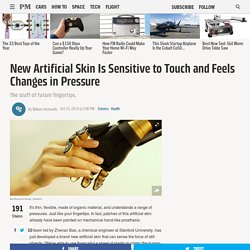
Just like your fingertips. In fact, patches of this artificial skin already have been painted on mechanical hand-like prosthesis. A team led by Zhenan Bao, a chemical engineer at Stanford University, has just developed a brand new artificial skin that can sense the force of still objects. Architecture that Integrates the Human Body. Diller Scofidio + Renfro, “Musings on a Glass Box,” view of screen in right gallery (all photos courtesy Luc Boegly) PARIS — The Fondation Cartier pour l’Art Contemporain in Paris commemorates its 30th anniversary with “Musings on a Glass Box,” a two-part immersive installation by controversial New York design studio Diller Scofidio + Renfro that nearly empties the museum’s ground floor.
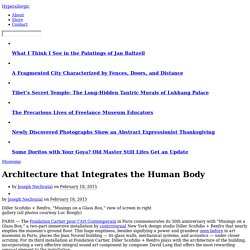
This huge emptiness, besides signifying a power and grandeur seen before in art museums in Paris, places the Jean Nouvel building — its glass walls, mechanical systems, and acoustics — under closer scrutiny. For its third installation at Fondation Cartier, Diller Scofidio + Renfro plays with the architecture of the building, incorporating a very effective integral sound art component by composer David Lang that offers the most rewarding sensual element to the installation. Microsoft Facial Recognition Guesses Your Emotions. Microsoft's beta tool guesses people’s emotions through facial recognition software.
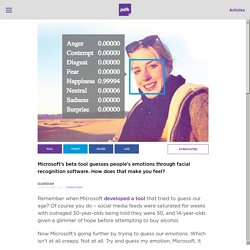
How does that make you feel? Remember when Microsoft developed a tool that tried to guess our age? Call of Duty: Black Ops III's New Twist? Seriously Brutal Body Horror. The first level in Call of Duty: Black Ops III is about torture.

As a Special Forces soldier in a grim future, the player is to extract a political official from a secret prison. As you infiltrate the facility, the game showcases gruesome scenes of waterboarding, beatings, and a unfortunate souls burning to death. The 2016 Met Gala Merges the Manmade and the Machine-Made. Apple sponsors next year's epic Metropolitan Museum of Art event showcasing how two unexpected worlds continue their centuries-old collision The theme for next year’s Costume Institute exhibition at The Metropolitan Museum of Art is titled Manus x Machina: Fashion in the Age of Technology.

The Met Gala is one of the biggest events on the fashion calendar, and for 2016, the theme highlights an important and current shift in how the clothing and technology industries can flourish when brought together.
Long Distance Heartbeat Sensor Connects From Afar. Movie - Empire. Ingestible Bio-Bots Design the Healthy Body of the Future. Futures Director at Pearlfisher on how ingestibles, smart pills and broadband-enabled digital tools will give us a clearer picture of our internal health Health has become a top priority for many of us.
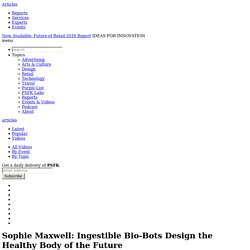
We want to take responsibility and find ways to be more proactive when it comes to managing it. Increasingly we are looking for the most natural solutions to facilitate this; through our new connections and sources of information, we now have access to more resources on a daily basis. Above all, an exciting new synergy between nature and technology is emerging, perhaps best illustrated by the coming bio-bot tide. As this convergence gains momentum, we are starting to see a new generation of brands and services tapping into this desire for optimization of natural resources to control and boost our personal health. One area of health currently gaining momentum is the growing awareness of the benefits of ‘helpful’ bacteria. MIT smartphone knows your heartbeat from across the room. Most fitness trackers take the form of a wearable wrist band -- which many users find unsightly or cumbersome.
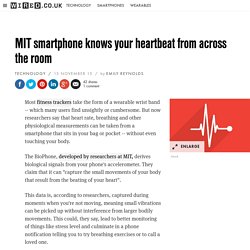
But now researchers say that heart rate, breathing and other physiological measurements can be taken from a smartphone that sits in your bag or pocket -- without even touching your body. The BioPhone, developed by researchers at MIT, derives biological signals from your phone's accelerometer. They claim that it can "capture the small movements of your body that result from the beating of your heart". This data is, according to researchers, captured during moments when you're not moving, meaning small vibrations can be picked up without interference from larger bodily movements.